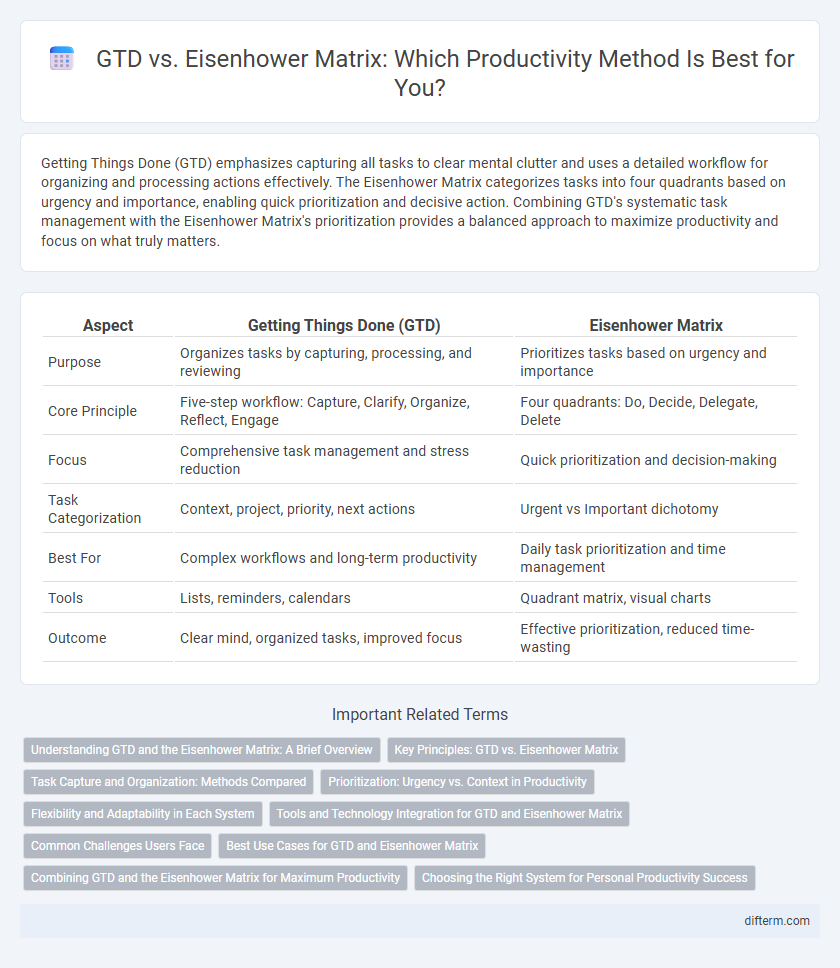Getting Things Done (GTD) emphasizes capturing all tasks to clear mental clutter and uses a detailed workflow for organizing and processing actions effectively. The Eisenhower Matrix categorizes tasks into four quadrants based on urgency and importance, enabling quick prioritization and decisive action. Combining GTD's systematic task management with the Eisenhower Matrix's prioritization provides a balanced approach to maximize productivity and focus on what truly matters.
Table of Comparison
| Aspect | Getting Things Done (GTD) | Eisenhower Matrix |
|---|---|---|
| Purpose | Organizes tasks by capturing, processing, and reviewing | Prioritizes tasks based on urgency and importance |
| Core Principle | Five-step workflow: Capture, Clarify, Organize, Reflect, Engage | Four quadrants: Do, Decide, Delegate, Delete |
| Focus | Comprehensive task management and stress reduction | Quick prioritization and decision-making |
| Task Categorization | Context, project, priority, next actions | Urgent vs Important dichotomy |
| Best For | Complex workflows and long-term productivity | Daily task prioritization and time management |
| Tools | Lists, reminders, calendars | Quadrant matrix, visual charts |
| Outcome | Clear mind, organized tasks, improved focus | Effective prioritization, reduced time-wasting |
Understanding GTD and the Eisenhower Matrix: A Brief Overview
Getting Things Done (GTD) is a productivity system developed by David Allen that emphasizes capturing, clarifying, organizing, reflecting, and engaging with tasks to reduce mental clutter and increase focus. The Eisenhower Matrix, also known as the Urgent-Important Matrix, prioritizes tasks by categorizing them into four quadrants based on urgency and importance, helping users decide which activities to do immediately, schedule, delegate, or eliminate. Both systems enhance task management but differ in approach: GTD focuses on workflow and actionability, while the Eisenhower Matrix concentrates on decision-making and prioritization.
Key Principles: GTD vs. Eisenhower Matrix
Getting Things Done (GTD) emphasizes capturing all tasks in a trusted system to clear mental clutter and organize actions by context, priority, and energy levels. The Eisenhower Matrix categorizes tasks into four quadrants based on urgency and importance, promoting focus on high-impact activities while delegating or eliminating less critical ones. Both frameworks enhance productivity by improving task prioritization but differ in methodology: GTD organizes workflow comprehensively, whereas the Eisenhower Matrix offers a strategic decision-making lens.
Task Capture and Organization: Methods Compared
The Getting Things Done (GTD) method emphasizes comprehensive task capture by collecting all tasks into a trusted system and organizing them into actionable contexts, enhancing clarity and flow. In contrast, the Eisenhower Matrix prioritizes tasks through a four-quadrant grid based on urgency and importance, streamlining decision-making processes. Both systems improve task management efficiency, but GTD excels in continuous task capture while the Eisenhower Matrix focuses on immediate prioritization and organization.
Prioritization: Urgency vs. Context in Productivity
Getting Things Done (GTD) emphasizes context-based prioritization by organizing tasks according to available resources and situational factors, enabling productivity tailored to the current environment. In contrast, the Eisenhower Matrix prioritizes tasks based on urgency and importance, categorizing activities to address critical deadlines and long-term goals effectively. Combining GTD's context sensitivity with the Eisenhower Matrix's urgency focus enhances time management and decision-making efficiency in complex workflows.
Flexibility and Adaptability in Each System
Getting Things Done (GTD) offers high flexibility by capturing tasks and ideas in a comprehensive system that adapts to dynamic workflows, allowing users to review and adjust priorities frequently. The Eisenhower Matrix provides clear adaptability by categorizing tasks into four quadrants based on urgency and importance, enabling quick decision-making but requiring strict discipline to reevaluate task placement regularly. Both systems accommodate changing priorities, with GTD excelling in managing complex projects and the Eisenhower Matrix streamlining immediate task prioritization.
Tools and Technology Integration for GTD and Eisenhower Matrix
Getting Things Done (GTD) leverages digital tools like Todoist, Evernote, and Microsoft OneNote to capture, organize, and track tasks systematically, enabling seamless integration with calendars and email for enhanced task management. The Eisenhower Matrix benefits from applications such as Trello and Priority Matrix, which visually separate tasks into urgent-important quadrants, facilitating priority-based decision-making through drag-and-drop interfaces and real-time collaboration features. Both methodologies utilize cloud-based platforms and mobile apps to synchronize task lists across devices, but GTD emphasizes next-action clarity while the Eisenhower Matrix focuses on urgency and importance for prioritization.
Common Challenges Users Face
Users of Getting Things Done (GTD) often struggle with maintaining consistent review habits and managing task overload due to its emphasis on capturing all commitments. The Eisenhower Matrix presents difficulties in accurately prioritizing tasks within its four quadrants, leading to time spent on low-impact activities. Both methods require discipline, but challenges arise from balancing complexity in GTD and subjectivity in Eisenhower's urgent-important distinctions.
Best Use Cases for GTD and Eisenhower Matrix
Getting Things Done (GTD) excels in managing complex projects with multiple actionable steps, making it ideal for knowledge workers and individuals handling diverse, long-term tasks. The Eisenhower Matrix is best suited for quick prioritization of daily tasks based on urgency and importance, helping users focus on what requires immediate attention. Combining GTD for comprehensive task capture and the Eisenhower Matrix for time-sensitive decision-making optimizes productivity across various workflows.
Combining GTD and the Eisenhower Matrix for Maximum Productivity
Combining Getting Things Done (GTD) with the Eisenhower Matrix enhances productivity by integrating GTD's comprehensive task capture and organization system with the Matrix's clear priority categorization. This hybrid approach enables users to systematically collect and clarify tasks through GTD while efficiently prioritizing them into urgent-important quadrants defined by the Eisenhower Matrix. Implementing both methods together streamlines workflow management, reduces procrastination, and ensures focus on high-impact activities for maximum productivity.
Choosing the Right System for Personal Productivity Success
Choosing the right productivity system depends on individual workflow and task complexity. Getting Things Done (GTD) is ideal for those managing numerous detailed projects requiring comprehensive task organization and clear next steps. The Eisenhower Matrix suits individuals prioritizing tasks by urgency and importance to quickly identify critical activities and avoid distractions.
Getting Things Done (GTD) vs Eisenhower Matrix Infographic

 difterm.com
difterm.com